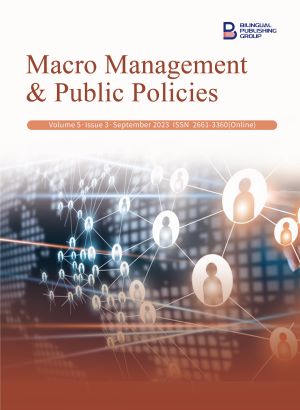-
926
-
365
-
267
-
265
-
264
The Demand for Money and Inflation in Ethiopia
DOI:
https://doi.org/10.30564/mmpp.v5i3.5722Abstract
One of the vital components of the macroeconomic model that helps policymaking is the demand for money function. Having reliable predictions on the money demand function helps in determining the optimum growth of money supply which is vital in controlling the inflation rate in the economy and also preventing monetary disturbances from affecting real output. In order to formulate and estimate the money demand function in Ethiopia, this study used quarterly data from 2000Q3 to 2021Q2 and employed the Ordinary Least Square method and Engle-Granger two-stage procedure for empirical analysis. The empirical result from the models indicates that, in the long run, all variables (real GDP, CPI inflation, real effective exchange rate, real interest rate and lagged real money balance) are significantly affecting the demand for money in Ethiopia. Whereas, the estimated coefficients of the short-run variable show that the real effective exchange rate, CPI inflation, and lagged real money balance are the main determinants of demand for money while the real GDP and real interest rate are insignificant. Another important finding is that absolute value of the coefficient of the error correction term implies that about 54.2% of the disequilibrium in real money demand is counter-balanced by short-run adjustment in each quarter. The study suggests that in conducting monetary policy, policymakers should consider not only the behavior of income and price but also the movement of exchange rates. The study also calls for appropriate formulation and estimation of the all-encompassing demand for money function that is capable of bringing stability to the growth of money coupled with sustainable economic growth.
Keywords:
Demand for money; Consumer price index (CPI); Gross domestic product (GDP)References
[1] Halicioglu, F., Ugur, M., 2005. On stability of the demand for money in a developing OECD country: The case of Turkey. Global Business and Economics Review. 7(2-3), 203-213.
[2] Goldfeld, S.M., Sichel, D.E., 1990. The demand for money. Handbook of Monetary Economics. 1, 299-356.
[3] Judd, J.P., Scadding, J.L., 1982. The search for a stable money demand function: A survey of the post-1973 literature. Journal of Economic Literature. 20(3), 993-1023.
[4] Friedman, B.M., 1988. Lessons on monetary policy from the 1980s. Journal of Economic Perspectives. 2(3), 51-72.
[5] Ghatak, S., Ghatak, S., 1995. The Keynesian and monetarist views on the importance of money. Monetary Economics in Developing Countries. 8-45.
[6] Ambe, M.E., 2019. Money demand and economic growth in Ethiopia. Developing Country Studies. 9(1).
[7] Yesigat, A., Rao, T.K., Nagaraja, G., 2018. Determinants of demand for money and its stability in Ethiopia. International Journal of Research and Analytical Reviews. 5(4), 349-360.
[8] Kibret, H., 2003. Economic Reform and Stability of the Money Demand Function in Ethiopia [Internet]. Available from: https://nbebank.com/wp-content/uploads/pdf/staff%20working%20paper/Economic%20Reform%20and%20Stability%20of%20the%20Money%20demand%20function%20in%20Ethiopia.pdf
[9] Sterken, E., 2004. Demand for money and shortages in Ethiopia. Applied Economics Letters. 11(12), 759-769.
[10] Iyke, B.N., Ho, S.Y., 2017. Monetary uncertainty and the demand for money in Ghana. The Journal of Developing Areas. 51(4), 1-13.
[11] Anwar, S., Asghar, N., 2012. Is demand for money stable in Pakistan?. Pakistan Economic and Social Review. 1-22.
[12] Qayyum, A., 2005. Modelling the demand for money in Pakistan. The Pakistan Development Review. 233-252.
[13] Djambak, S., Kahpi, M., Rohima, S., et al., 2020. Analysis factors that influence the money demand in Indonesia. Proceedings of the 5th Sriwijaya Economics, Accounting, and Business Conference (SEABC 2019). Atlantis Press: Amsterdam. pp. 184-188.
[14] Kadir, N., Nayan, S., Abdullah Fahami, N., 2013. Factors affecting demand for money in Japan/Norhidayu Rosli, Norsiah Kadir, Sabri Nayan and Norasyikin Abdullah Fahami. International Journal of Undergraduates Studies. 2(3), 15-18.
[15] Moroney, J.R., 2002. Money growth, output growth, and inflation: Estimation of a modern quantity theory. Southern Economic Journal. 69(2), 398-413.
[16] Laider, D.E.W., 1993. The demand for money: Theories, evidence and problems. Pearson: London.
[17] Mansaray, M., Swaray, S., 2012. Financial liberalization, monetary policy and money demand in Sierra Leone. Journal of Monetary and Economic Integration. 12(2), 62-90.
[18] Iyoboyi, M., Pedro, L.M., 2013. The demand for money in Nigeria: Evidence from bounds testing approach. Business and Economics Journal.
[19] Sriram, S.S., 2000. A survey of recent empirical money demand studies. IMF Staff Papers. 47(3), 334-365.
[20] Ericsson, N.R., MacKinnon, J.G., 2002. Distributions of error correction tests for cointegration. The Econometrics Journal. 5(2), 285-318.
Downloads
How to Cite
Issue
Article Type
License
Copyright © 2023 Author(s)

This is an open access article under the Creative Commons Attribution-NonCommercial 4.0 International (CC BY-NC 4.0) License.




 Solomon Senbeto Godana
Solomon Senbeto Godana

